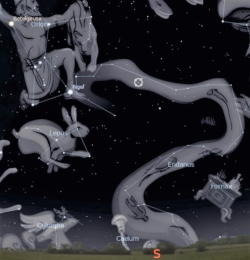This Week’s Sky at a Glance, 2024 Jan. 13 – Jan. 20
This Week’s Sky at a Glance, 2024 Jan. 13 – Jan. 20
There is one river seen from New Brunswick that is completely ice-free all winter, but we can only see it on clear nights. Eridanus the River, the fifth largest constellation in area of the sky, has its head just off the foot of Orion near Rigel. Even when it is at its highest in our sky, the river’s meandering path takes it more than ten degrees below the horizon to where it terminates at Achernar, the ninth brightest star.
In mythology the river was associated with Phaethon, a mortal son of Apollo. Apollo drove the Sun, a golden chariot powered by mighty steeds, across the sky by day. Phaethon was allowed to drive it one day but he couldn’t control the steeds. They ran amok, scorching the sky (the Milky Way) and the Earth (Sahara), until Zeus blasted Phaethon with a thunderbolt and he fell to his death in the river. The twisty constellation Eridanus was also considered to be the path of souls.
Although we can’t see Achernar without travelling to Florida, there is a notable star in Eridanus that we can see from outside a city. Omicron-2 Eridani, also called 40 Eridani or Keid (circled on the map), has a famous fictional and fascinating planet: Vulcan, the home of Spock. Did you know that there was once believed to be a planet closer to the Sun than Mercury? It was named Vulcan after the Roman god of fire, metalworking and the forge. Anomalies in Mercury’s orbit were thought to be due to an interior planet, and some astronomers even claimed to have seen it crossing the Sun. The anomalies of Mercury’s orbit were finally explained by Albert Einstein in his General Theory of Relativity. Coincidentally, regarding the god Vulcan, the constellation Fornax the Furnace barely crests our horizon near Eridanus.
This Week in the Solar System
Saturday’s sunrise is at 8:01 and sunset will occur at 5:04, giving 9 hours, 3 minutes of daylight. Next Saturday the Sun will rise at 7:56 and set at 5:13, giving 9 hours, 17 minutes of daylight.
The Moon is near Saturn on Sunday, at first quarter Wednesday, and on late afternoon Thursday it is a thumb-width upper left of Jupiter. This provides an opportunity to spot Jupiter naked-eye before sunset. After sunset Monday telescope users might see Jupiter’s moon Europa pop out from behind the planet at 5:37, disappear into shadow 20 minutes later and reappear at 8:19, while Io reappears from Jupiter’s shadow at 6:37. Saturn sets around 8:20 pm midweek so observe it early. Mercury remains a fist-width lower left of Venus all week, rising around 6:30 am this weekend and followed by Mars 45 minutes later.
On Sunday evening at 8 pm, tune in to the Sunday Night Astronomy Show via the Facebook page or YouTube channel of Astronomy by the Bay. Famous Canadian astrophotographer Alan Dyer will be the guest, talking about how to image the total solar eclipse in April.

